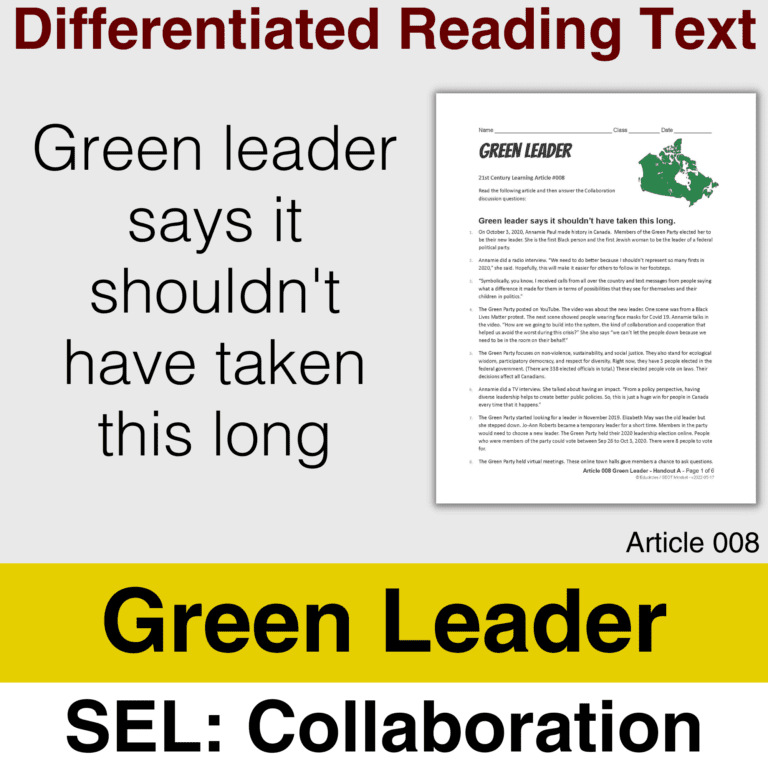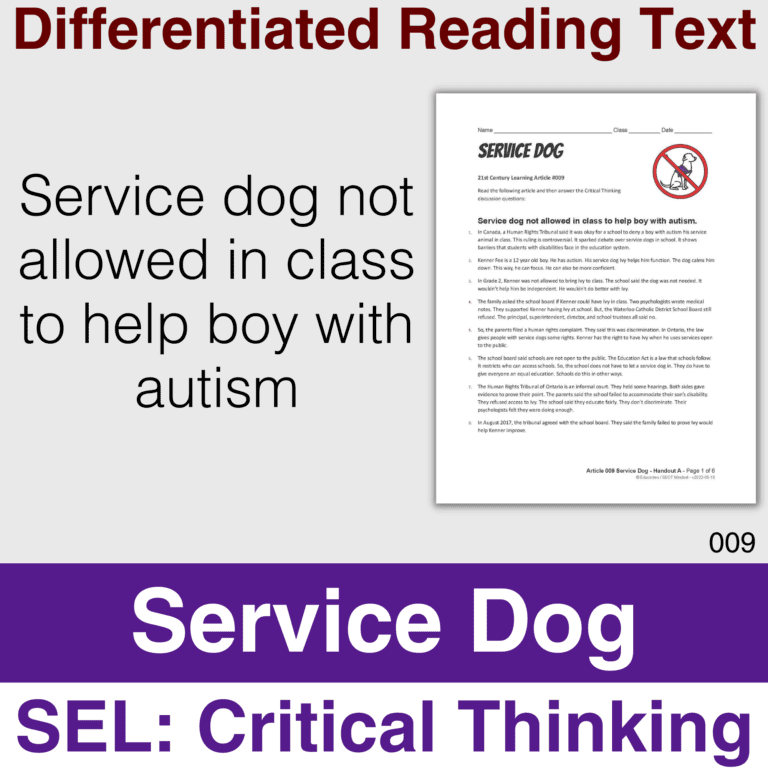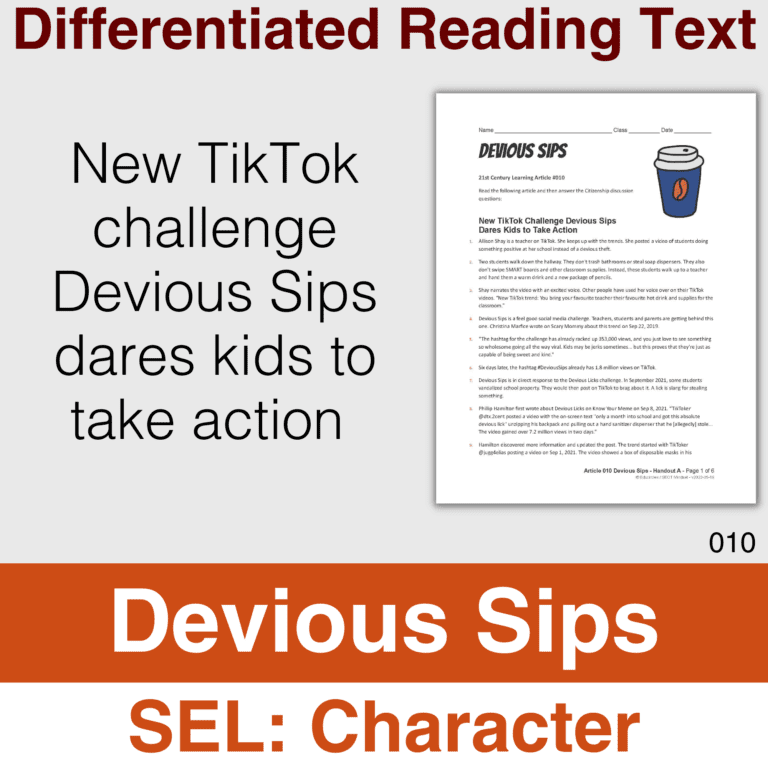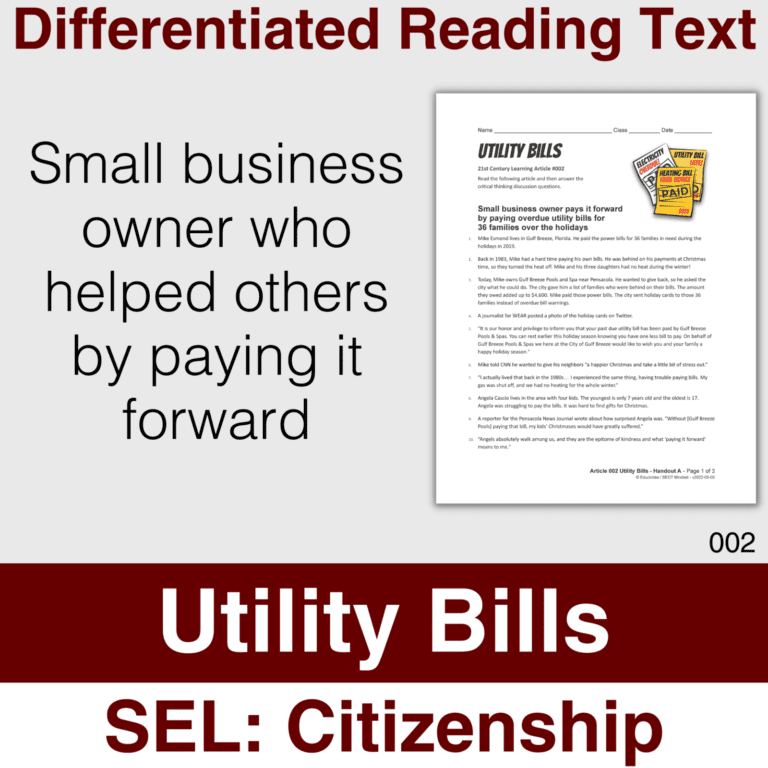How much did Amazon make during the pandemic? How do sellers cheat the system?
Reading response article about CRITICAL THINKING and MULTIPLE POINTS of VIEW.
The informational text is differentiated into four reading levels (Grades 6, 8, 10, and 12.)
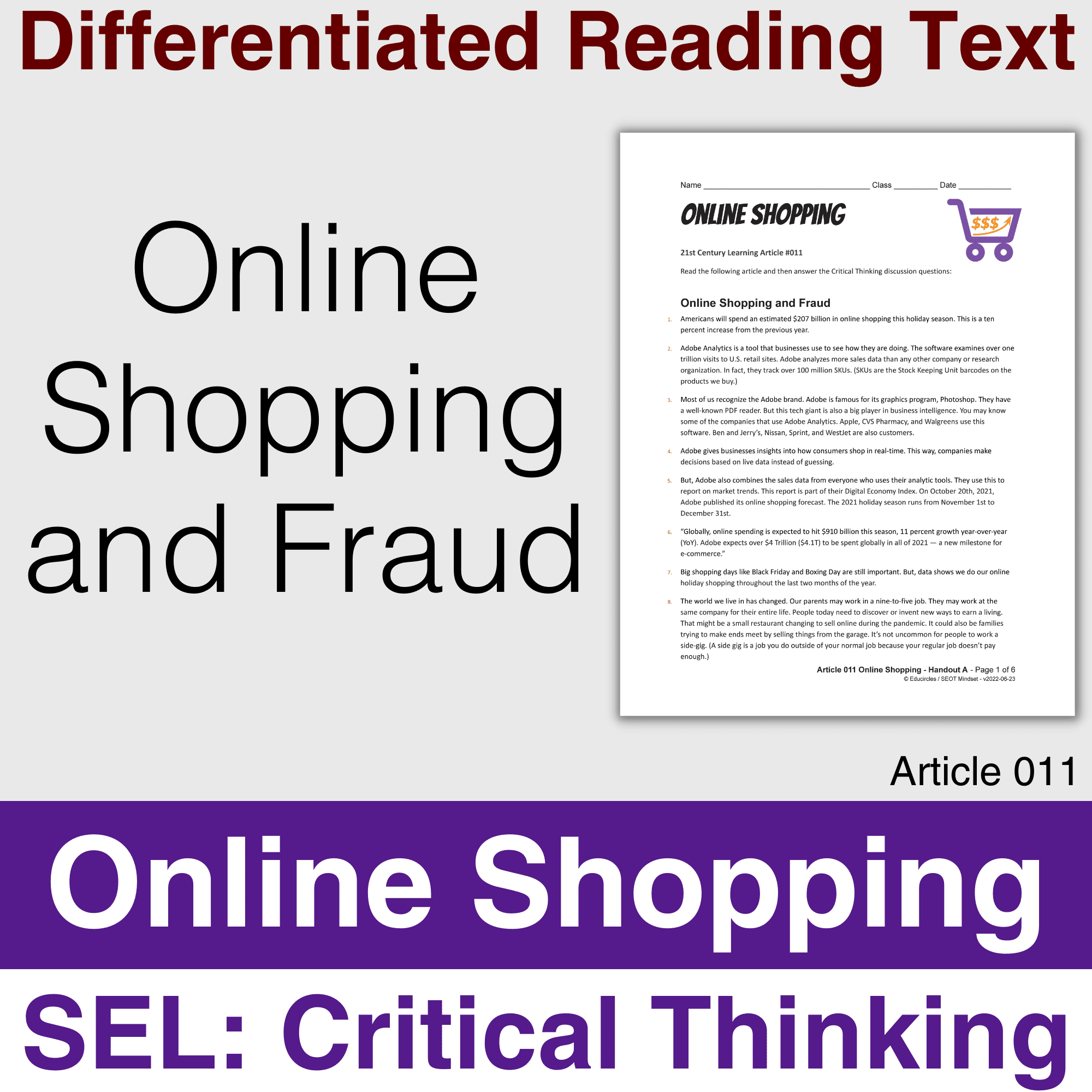
Want to see exactly what you get before you buy this product?
- Watch the PREVIEW VIDEO
- Look at the PREVIEW PDF.
(It is a watermarked version of the entire PDF resource.)
This article goes well with the MAKING CONNECTIONS reading strategy.
Do your students know…
- How much do we spend online? (Try guessing.)
- How much did Amazon make during the pandemic?
- How does Amazon calculate product ratings?
(It’s not a simple average.)
- How do sellers cheat the system by getting fake reviews?
- Why would people be willing to leave fake reviews?
This article includes a Critical Thinking mini-lesson.
- How to be FULL-MINDED and explore multiple sides of an issue
- Brainstorming prompts to think about different points of view.
The discussion handout includes six questions.
Online Shopping and Fraud
Americans will spend an estimated $207 billion in online shopping this holiday season. This is a ten percent increase from the previous year.
Adobe Analytics is a tool that businesses use to see how they are doing. The software examines over one trillion visits to U.S. retail sites. Adobe analyzes more sales data than any other company or research organization. In fact, they track over 100 million SKUs. (SKUs are the Stock Keeping Unit barcodes on the products we buy.)
Most of us recognize the Adobe brand. Adobe is famous for its graphics program, Photoshop. They have a well-known PDF reader. But this tech giant is also a big player in business intelligence. You may know some of the companies that use Adobe Analytics. Apple, CVS Pharmacy, and Walgreens use this software. Ben and Jerry’s, Nissan, Sprint, and WestJet are also customers.
Adobe gives businesses insights into how consumers shop in real-time. This way, companies make decisions based on live data instead of guessing.
But, Adobe also combines the sales data from everyone who uses their analytic tools. They use this to report on market trends. This report is part of their Digital Economy Index. On October 20th, 2021, Adobe published its online shopping forecast. The 2021 holiday season runs from November 1st to December 31st.
- “Globally, online spending is expected to hit $910 billion this season, 11 percent growth year-over-year (YoY). Adobe expects over $4 Trillion ($4.1T) to be spent globally in all of 2021 — a new milestone for e-commerce.”
Big shopping days like Black Friday and Boxing Day are still important. But, data shows we do our online holiday shopping throughout the last two months of the year.
The world we live in has changed. Our parents may work in a nine-to-five job. They may work at the same company for their entire life. People today need to discover or invent new ways to earn a living. That might be a small restaurant changing to sell online during the pandemic. It could also be families trying to make ends meet by selling things from the garage. It’s not uncommon for people to work a side-gig. (A side gig is a job you do outside of your normal job because your regular job doesn’t pay enough.)
You can buy at any time using sites like Kijiji, Facebook Marketplace, eBay, and Etsy. Once a person sells something on these websites, they have to ship the item to the buyer.
Some companies now also offer fulfillment services. This makes it easier for people to sell online. For example, Amazon will handle shipping, returns, and customer service. They want to help you “deliver smiles.”
All sorts of people sell on Amazon. The “Sell on Amazon” webpage explains why. “Reach millions. Fresh new startups and Fortune 500s. B2B and B2C. Brand owners and resellers. They all sell on Amazon for a reason: 300 million customers shop our stores worldwide.”
Covid has changed the way we shop. Amazon is clearly a winner. Between January to March of 2021, Amazon tripled its profit compared to January to March in 2020. In other words, Amazon made more money. This is because the pandemic forced everyone to stay at home. Being at home meant more shopping online. Amazon’s financial results show how much. “Net income increased to $8.1 billion in the first quarter … compared with net income of $2.5 billion … in first quarter 2020.”
If you like this content, you should definitely check out the reading comprehension strategies PDF bundle.
Everyone can sell on Amazon. But, product reviews can drastically increase or decrease sales. (Unless you’re a huge brand.) The “Amazon Verified Purchase” review label is a gamechanger. It can make or break your store.
Amazon’s help page explains the label. “An ‘Amazon Verified Purchase’ review means we’ve verified that the person writing the review purchased the product at Amazon and didn’t receive the product at a deep discount.”
The Verified Purchase review label directly impacts a product’s rating. Better ratings lead to more sales. Amazon product ratings are not a simple average. Another help page explains how they use machine learning. Computers come up with a star rating. Algorithms consider “how recent the rating or review is and verified purchase status.”
Nicole Nguyen wrote a series of articles about Amazon in 2019. She writes for BuzzFeed News. She interviewed Jessica, a woman who buys things on Amazon with her own money. (Jessica is not her real name.) Jessica’s purchases are real. Her reviews are not. Jessica writes five-star reviews. Then, she gets her money back from the companies that sell these products.
“Jessica told BuzzFeed News she doesn’t think she’s gaming the system; she’s trying to help brands grow their businesses in Amazon’s massive marketplace.”
Nguyen reported that Amazon sellers run Facebook ads. They want people to leave a 5-star review. If you do, they will give you a full refund. If you click on some ads, a Facebook chatbot explains what to do. It will show you how to leave a review without looking fake.
“Search for a particular keyword, look for the brand name…, add the product to your Amazon Wish list, then order the product. Make sure you don’t use a gift card. Half of the refund will be issued within 24 hours of receipt. The other half will arrive after you send a screenshot of your review. But be sure to wait ONE WEEK before reviewing.”
Teachers, when you purchase this resource, you get this article in PDF, Google Doc, and Microsoft Word format differentiated at multiple reading levels. Otherwise, if you just copy / paste this content into a document, you’ll have to search for this paragraph so it doesn’t distract your students.
The product using this Facebook ad had the “Amazon’s Choice” label. “Amazon’s Choice” implies endorsement by Amazon. But algorithms determine which products get that label. And, fake reviews can influence algorithms.
U.S. Senators Bob Menendez and Richard Blumenthal took action. They asked Amazon for more information. They wanted to know how Amazon figured out who gets the “Amazon’s Choice” badge. The senators used examples from Nguyen’s article. The article was about how “‘Amazon’s Choice’ does not necessarily mean a product is good.”
“We write to express our concerns about the “Amazon’s Choice” badge and whether it deceives consumers into purchasing products of inferior quality… Your customers reasonably rely on the “Amazon’s Choice” badge to guide their final purchasing decisions… We are concerned the badge is assigned in an arbitrary manner, or worse, based on fraudulent product reviews.”
Brian Huseman works at Amazon. He is the Vice President of Public Policy. He responded and clarified what Amazon does. Amazon employees do not personally review the products that receive the badge. So employees are not looking at each product. They are not checking to make sure products meet a certain quality.
“While employees do not manually review every one of the more than 2 million products badged as Amazon’s Choice each month, we continuously monitor and review the program to refine and improve how we choose products we think customers will love. In the rare instances when we become aware of concerns with products we feature, we act quickly to address those concerns, including removing the Amazon’s Choice badge.”
Huseman said that algorithms decide which products get the “Amazon’s Choice” badge. Their computers look at many factors. This includes things like “popularity, available inventory, customer reviews, and ratings.” It also considers “pricing, customer service contacts, return rates, and product quality.” Huseman also confirmed everyone sees the “Amazon’s Choice” badge on the same products. Amazon does not change the label based on a buyer’s search and purchasing history.
Indeed, fake reviews are an issue. They directly influence our decisions to buy online. In 2018, Amazon spent over $400 million to fight misconduct. They were trying to stop review abuse and fraud. Amazon says giving incentives for reviews is not allowed. They may close your account. They might even take legal action. Huseman told the two senators that Amazon is suing over 1,000 defendants for reviews abuse.
Online e-commerce is a $4 trillion-a-year industry. There are a lot of different stakeholders. Many people are interested in this game. There is a neverending cycle of people trying to cheat the system and people trying to stop them. As people innovate to avoid detection, companies create more accurate fraud detection systems.
Ultimately, we need to use critical thinking to help us make more informed decisions before buying online.
Critical Thinking Discussion Questions:
One aspect of critical thinking means to be “full-minded” to help us make an informed decision.
Sometimes, we make a quick decision with limited information.
Try to fill your mind with high-quality information to help you make an informed decision.
Look for facts from opposing points of view to challenge your opinions. Be open-minded.
Spend a few minutes brainstorming as many different nouns (people, places, companies, organizations, ideas) that could fit the following sentence stems.
(NOTE: You cannot use “Amazon” or “fake reviews” in your brainstorming answers.)
Critical Thinking – Brainstorm #1
Why might _________________ do more to stop fake reviews?
Why might they do less to stop fake reviews?
How does _________________ benefit if there are fake reviews?
How might they be at a disadvantage if there are fake reviews?
Critical Thinking – Brainstorm #2
Why might Amazon do more to ________________ ?
Why might Amazon do less of that?
How does Amazon benefit if they ____________________?
How might they be at a disadvantage if they ____________________?
Reading Comprehension Questions
Based on the article and the ideas about active Critical Thinking in the article, how would you answer the following questions:
- What is the problem in this article? Who wins? Who loses?
- Who are the different stakeholders/people identified in this article? What might their points of view be?
- Whose perspectives are missing from this article? What might their points of view be?
- How can we think more critically when we shop on Amazon?
- How can we use the information in this article to help us think more critically when we shop online on other websites?
- Whose responsibility is it to solve this problem identified in question #1? Explain your thinking.
